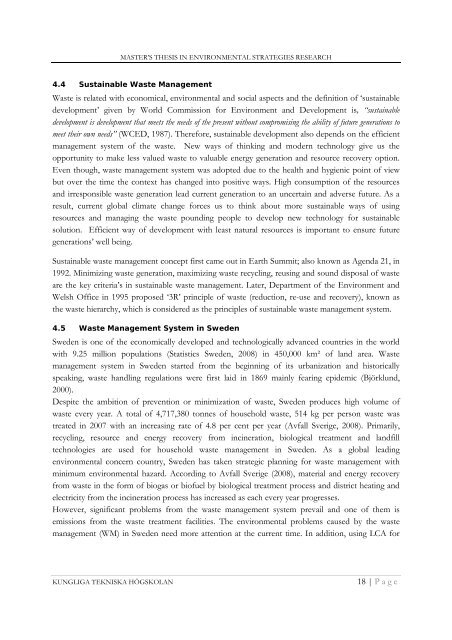Technical Development of Waste Sector in Sweden: Survey
Technical Development of Waste Sector in Sweden: Survey
Technical Development of Waste Sector in Sweden: Survey
You also want an ePaper? Increase the reach of your titles
YUMPU automatically turns print PDFs into web optimized ePapers that Google loves.
MASTER’S THESIS IN ENVIRONMENTAL STRATEGIES RESEARCH<br />
4.4 Susta<strong>in</strong>able <strong>Waste</strong> Management<br />
<strong>Waste</strong> is related with economical, environmental and social aspects and the def<strong>in</strong>ition <strong>of</strong> ‘susta<strong>in</strong>able<br />
development’ given by World Commission for Environment and <strong>Development</strong> is, “susta<strong>in</strong>able<br />
development is development that meets the needs <strong>of</strong> the present without compromis<strong>in</strong>g the ability <strong>of</strong> future generations to<br />
meet their own needs” (WCED, 1987). Therefore, susta<strong>in</strong>able development also depends on the efficient<br />
management system <strong>of</strong> the waste. New ways <strong>of</strong> th<strong>in</strong>k<strong>in</strong>g and modern technology give us the<br />
opportunity to make less valued waste to valuable energy generation and resource recovery option.<br />
Even though, waste management system was adopted due to the health and hygienic po<strong>in</strong>t <strong>of</strong> view<br />
but over the time the context has changed <strong>in</strong>to positive ways. High consumption <strong>of</strong> the resources<br />
and irresponsible waste generation lead current generation to an uncerta<strong>in</strong> and adverse future. As a<br />
result, current global climate change forces us to th<strong>in</strong>k about more susta<strong>in</strong>able ways <strong>of</strong> us<strong>in</strong>g<br />
resources and manag<strong>in</strong>g the waste pound<strong>in</strong>g people to develop new technology for susta<strong>in</strong>able<br />
solution. Efficient way <strong>of</strong> development with least natural resources is important to ensure future<br />
generations’ well be<strong>in</strong>g.<br />
Susta<strong>in</strong>able waste management concept first came out <strong>in</strong> Earth Summit; also known as Agenda 21, <strong>in</strong><br />
1992. M<strong>in</strong>imiz<strong>in</strong>g waste generation, maximiz<strong>in</strong>g waste recycl<strong>in</strong>g, reus<strong>in</strong>g and sound disposal <strong>of</strong> waste<br />
are the key criteria’s <strong>in</strong> susta<strong>in</strong>able waste management. Later, Department <strong>of</strong> the Environment and<br />
Welsh Office <strong>in</strong> 1995 proposed ‘3R’ pr<strong>in</strong>ciple <strong>of</strong> waste (reduction, re-use and recovery), known as<br />
the waste hierarchy, which is considered as the pr<strong>in</strong>ciples <strong>of</strong> susta<strong>in</strong>able waste management system.<br />
4.5 <strong>Waste</strong> Management System <strong>in</strong> <strong>Sweden</strong><br />
<strong>Sweden</strong> is one <strong>of</strong> the economically developed and technologically advanced countries <strong>in</strong> the world<br />
with 9.25 million populations (Statistics <strong>Sweden</strong>, 2008) <strong>in</strong> 450,000 km² <strong>of</strong> land area. <strong>Waste</strong><br />
management system <strong>in</strong> <strong>Sweden</strong> started from the beg<strong>in</strong>n<strong>in</strong>g <strong>of</strong> its urbanization and historically<br />
speak<strong>in</strong>g, waste handl<strong>in</strong>g regulations were first laid <strong>in</strong> 1869 ma<strong>in</strong>ly fear<strong>in</strong>g epidemic (Björklund,<br />
2000).<br />
Despite the ambition <strong>of</strong> prevention or m<strong>in</strong>imization <strong>of</strong> waste, <strong>Sweden</strong> produces high volume <strong>of</strong><br />
waste every year. A total <strong>of</strong> 4,717,380 tonnes <strong>of</strong> household waste, 514 kg per person waste was<br />
treated <strong>in</strong> 2007 with an <strong>in</strong>creas<strong>in</strong>g rate <strong>of</strong> 4.8 per cent per year (Avfall Sverige, 2008). Primarily,<br />
recycl<strong>in</strong>g, resource and energy recovery from <strong>in</strong>c<strong>in</strong>eration, biological treatment and landfill<br />
technologies are used for household waste management <strong>in</strong> <strong>Sweden</strong>. As a global lead<strong>in</strong>g<br />
environmental concern country, <strong>Sweden</strong> has taken strategic plann<strong>in</strong>g for waste management with<br />
m<strong>in</strong>imum environmental hazard. Accord<strong>in</strong>g to Avfall Sverige (2008), material and energy recovery<br />
from waste <strong>in</strong> the form <strong>of</strong> biogas or bi<strong>of</strong>uel by biological treatment process and district heat<strong>in</strong>g and<br />
electricity from the <strong>in</strong>c<strong>in</strong>eration process has <strong>in</strong>creased as each every year progresses.<br />
However, significant problems from the waste management system prevail and one <strong>of</strong> them is<br />
emissions from the waste treatment facilities. The environmental problems caused by the waste<br />
management (WM) <strong>in</strong> <strong>Sweden</strong> need more attention at the current time. In addition, us<strong>in</strong>g LCA for<br />
KUNGLIGA TEKNISKA HÖGSKOLAN<br />
18 | Page
















